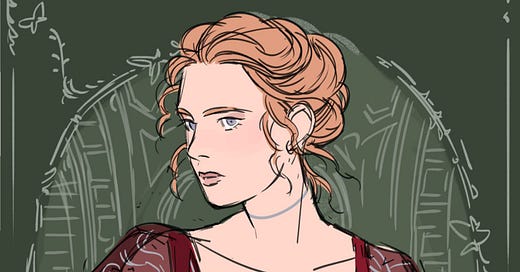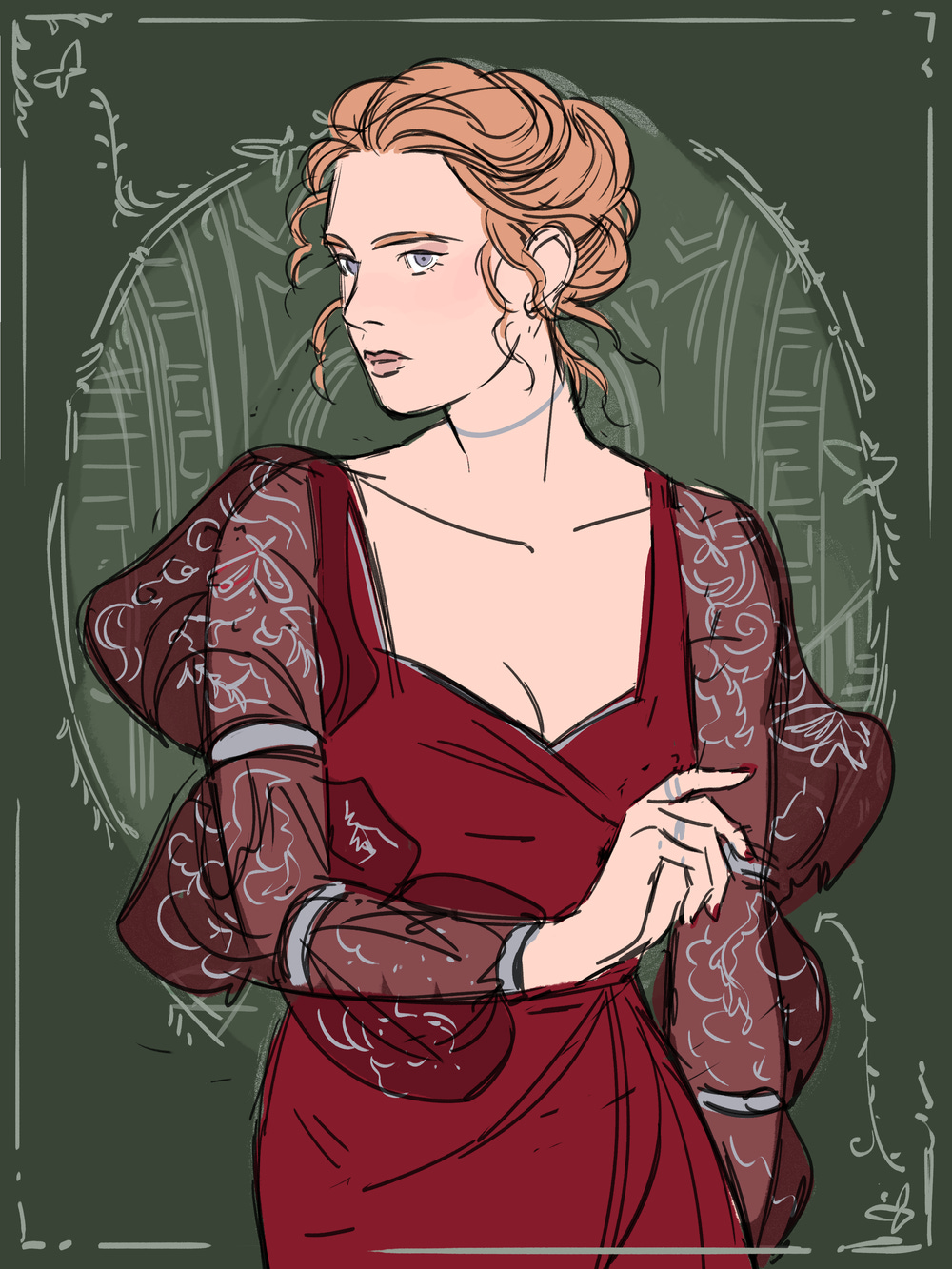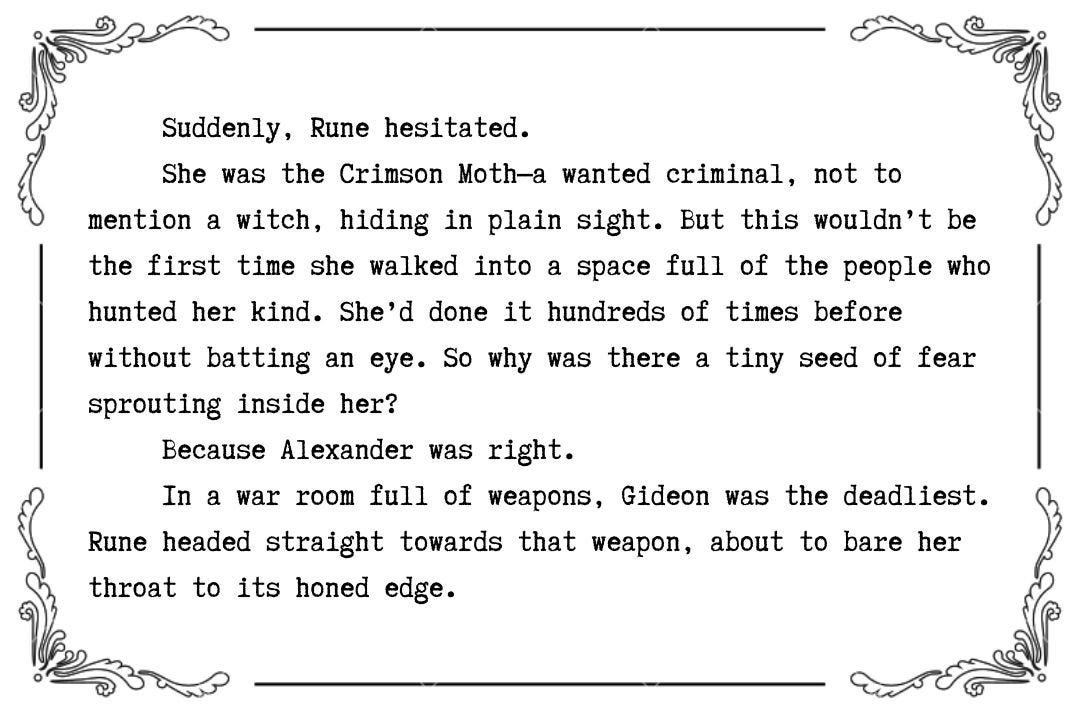How I wrote The Crimson Moth
Create a character with an obsession, then follow. – Ray Bradbury
I’ve written six books to date.
Four are published, with a fifth on the way.
Two were thrown out and completely rewritten from scratch (The Last Namsara + Edgewood).
One will never see the light of day.
I’m working on the seventh now.
After six finished books—and a bunch of half-finished ones—I won’t say I know what I’m doing, because (hopefully) I’m always learning and growing. But I do have a system these days. And since one of my most asked questions is “How do you write a book?” I thought I’d talk about it here.
So: this is how I wrote The Crimson Moth (coming March 2024).
For me, a book typically starts years before I ever write a word of it. I’ve always been low-key obsessed with The Scarlet Pimpernel by Baroness Orczy, and in early 2019, I was going through another craze where I read the book, watched the films, watched the tv show (do not recommend—I was desperate and just wanted more Percy Blakeney, okay?), and then frantically searched for retellings just so I could continue consuming all things Pimpernel. But I couldn’t find any retellings other than what I’d already read. So I thought: What if I wrote my own? What would it be like? How could I twist it?
I couldn’t stop thinking about it. I remember bringing it up with my husband one night while we were doing dishes. It was mid-winter and therefore pitch dark outside, and the fire was crackling in the wood-stove. He was washing, I was drying, and all of my ideas for the story fell out in a rush while he painstakingly listened like the kind husband he is.
But the ideas were only half-cooked. And I had other books to write. So I tucked the story away in the back of my mind and let it simmer.
Fast forward to Fall of 2021. We were living in an Airstream (me, my husband, our elderly dog, and our 6-month-old baby). I was getting up at 3:30am every morning (thanks, hormonal insomnia!) and cramming in as much writing as I could. That’s when I untucked the idea. Edgewood was coming out in a few months and I wanted a new book to work on. I pitched it to my agent: “What if I gender-swapped The Scarlet Pimpernel and instead of French aristocrats getting executed, they’re witches who once ruled and were overthrown?” We pitched it to my editor, who bought the book.
This story had simmered long enough that I had lots of ingredients to work with: a premise, characters, a magic system, and a sense of the story’s arc. So it was time to do a deep dive into my two protagonists: Rune & Gideon.
This is the most important step for me. I do the bulk of my character work upfront, then tweak it as I go. The term GMC (“Goal, Motivation, Conflict”) gets thrown around in writing spaces sometimes and you could say that this is a version of that, just broken down into more parts. I learned this technique from Franny Billingsley when she mentored me years and years ago.
Before I start drafting, I need to know my character’s:
History
Wound
Desire
Obsession
Inner Need
Misbelief
Sometimes I also need to know the theme. It usually takes me a while to figure all this out, because each item in that list is interwoven with all the others. A character’s desire vs their need, for example, is especially important because these two things must be irreconcilable. If a character gets what they want, they can’t get what they need, and vice versa. Which makes for lots of delicious conflict. Equally important is the misbelief—a flawed belief or lie that’s hurting them or the people around them—which they will have to turn against at some point, and that 180 degree turn reveals the story’s theme.
(Is this stuff interesting to you? Let me know in the comments. I’m never sure how much of the nitty-gritty details readers want me to go into.)
Once I have a solid sense of my character, I start outlining. Outlining helps me get the story as close to “right” the first time. When I let myself figure out the plot as I write it, I tend to scrap the first (and sometimes second) draft and start over. Knowing my characters really, really well upfront, and then outlining the story based on who they need to become, helps me prevent that. (This is not the correct way to write a book; it’s just the way I currently write books.)
I use the 3-Act (or more) structure to outline. I’m a big fan of Robert McKee, who says a story needs at least 3 major reversals (one per act) to take a story to the end of the line. I try to follow that advice. If I get stuck, I pull out Save the Cat to see if it can help me figure out where and why I’ve gone off the rails. These days, I’ve also added Romancing the Beat to my process. If you’re writing romance, romantic fantasy, or just want to improve your romantic subplots, I highly recommend this little book. It’s super short and packed full of practical advice.
I think it’s important to note here that I do not follow any template or method to the letter. I use them as guidelines. Templates, guides, how-tos can be helpful, but they can be confining and sometimes make you overthink things when what you need to do is listen to your gut and follow your instincts.
Speaking of instincts: two other resources I’ve adopted into my process in recent years are this book on Universal Fantasy by Theodora Taylor and Writing for your Id by Jennifer Lynne Barnes. Both are about the same concept: shutting down that pretentious voice in your head that says the things you love are too trope-y or cliché or overdone, and instead, flipping off that voice and packing your story full of those things precisely because you love them. Think about your favourite books, comics, movies, shows, etc, then make a list of all the things that make those your favourites. You’ll very quickly realize there’s a lot of crossover.
For example, my favourite stories tend to feature the following:
girl protagonists
hate to love romance
dragons!!!
complex magic systems that act as metaphors for real life
class divides
gods that walk among mortals
cool mythology
death personified
cool weapons / fantasy tech
redemption arcs
etc!
All of this (character work + outline) takes me several weeks to a month to flesh out. When I’m finished my outline, it’s usually around 10-15k words (my outline for The Crimson Moth sequel is 30 single-spaced pages in Word). That’s very detailed, and it helps me draft fast because I have a strong sense of what each scene already looks like, as well as my character’s motivations and goals going into those scenes, before I write them. Some of this will change as I go, and I’m never married to an outline if it’s not working, but this process really works for me.
The other thing that helps me draft is my Alphasmart Neo, which I found on eBay. These little word processors were used in K-12 classrooms back in the nineties to teach students how to write. They don’t connect to the internet, and they have a screen so small you can only read the last couple sentences you typed (meaning you can’t edit as you go … though sometimes I still try!). I wrote the first draft of The Crimson Moth in two months by escaping to a cafe down the block with my Neo. I wrote for 2-3 hours every day. (I have a 1-year-old who’s only in preschool for a couple hours a day, so I have to maximize my time. This is how I did that.)
After that initial draft, I usually do 2 or 3 big edits after getting feedback from readers, my agent, and my editor. Then it’s on to smaller stuff (copyedits, proofreading, etc). Once edits are done, it’s out of my hands and I can shift all of my attention to the next book.
That’s how I wrote The Crimson Moth, which I am super excited for you to read. There is a bunch of fun stuff happening behind the scenes right now, none of which I can officially announce yet, but here are 3 things I can share…
First of all, here are some things you’ll find in this romantasy book: post-revolution witches, magic that levels up, fake-dating-without-realizing-you’re-fake-dating-because-you-need-to-take-each-other-down (someone recently described it as a magical “Mr. & Mrs. Smith”), machiavellian girl villains, regency-esque ballrooms + gowns + dancing, two brothers who are loyal to each other but in love with the same girl, normalization of periods, etc.
Secondly, here’s that art sneak peek I promised in my last post. (This is just a sketch. It’s not final.) Meet Rune Winters, the young heiress and socialite hiding a deadly secret in The Crimson Moth:
And last, here’s a brief snippet from the book:
I’ll share more details as soon as I’m allowed.
In the meantime, if you have any burning questions for me to address in upcoming posts (about writing, publishing, or The Crimson Moth) let me know in the comments. I’d love to answer them!
xo Kristen






This book has been added to my list of absolute favorites. The characters, the story, the romantic tension had me hooked from beginning to end. I’m curious to know how long took you to write the book once you started the character development and outlining?
I just finished your book crimson moth from the BOTM subscription. I’m obsessed and need more! What happens next? Can’t wait to find out!